– 20 Years Ago
by Sachi Sri Kantha, reposted from June 2004
One of the English words which had depreciated in value drastically is ‘genocide’. This is a pity, since it’s a relatively ‘new’ word, coined only 60 years ago, in 1944. The New Yorker of May 3, 2004, carried a short column on the genocide theme in its ‘Talk of the Town’ pages. First, I provide excerpts of this column by Gary Bass. He refers to the style dilemma at the New York Times, where ‘the long-standing practice that writers are not supposed to call the Armenian genocide of 1915 a genocide’. The New York Times, being partisan to the Jewish interests, would prefer to restrict the use of ‘genocide’ to the Jewish suffering under the hand of Hitler’s regime. Bass relates how Bill Keller (who had been the New York Times’ executive editor since July 2003) sees the dilemma in the usage of the ‘genocide’ word. To quote,
“[Bill] Keller, who became the paper’s executive editor last July, finally changed the policy earlier this month. During a telephone conversation the other day, he said his reporting in Armenia and Azerbaijan ‘made me wary of reciting the word genocide as a casual accusation, because in the various ethnic conflicts that arose as the Soviet Union came apart everyone was screaming genocide at everyone else.”
Most scholars use the United Nation’s definition of genocide, from the 1948 Genocide Convention: killing or harming people ‘with intent to destroy, in whole or in part, a national, ethnical, racial or religious group’. But, Keller says, ‘we [egg-heads at the New York Times, I believe] were using a dictionary definition that was the purist definition – to eliminate all of a race of people from the face of the earth.’ The Times’s position was based on the notion that the systematic killing that began in 1915 applied mainly to Armenians inside the Ottoman Empire.” [New Yorker, May 3, 2004, pp.35-36]
This is a relevant and important issue for the Eelam Tamils. The ‘G’ word is now being used indiscriminately by anti-Tamil hacks in Colombo, demented defectors like Karuna and even spurious opinion-makers at Harvard University, as a crime committed by the LTTE. If there has been genocide in the blessed island south of India, for the past 21 years, it has been against the Tamils. The perpetrators have been the Sinhalese majority. Period. That Muslims are suffering from genocide at the hands of LTTE is arrant nonsense, considering the fact that the Muslims in the Sri Lankan armed forces have committed similar, if not worse, atrocities, joining hands with the Sinhalese, against Tamil civilians in the North-East. Now, playing to the gallery for sponsorship is political pervert Karuna [and most likely his ghost-writer], who for the past few months has been using the ‘G’ word against the LTTE leader Pirabhakaran for smear purposes. But, none in their saner counsel, would believe Karuna’s or his ghost-writer’s diatribes.
What I present below, a two-part travelogue by an Indian journalist S.Parthasarathy, is a time capsule. Parthasarathy visited Jaffna peninsula in September-October of 1984. His travelogue appeared in the then Madras Hindu; yes, now the Chennai Hindu. What a difference 20 years makes! Now, you would not see anything like Parthasarathy’s descriptions in the pages of the Hindu newspaper. The reasons are too obvious. First, The House of Hindu publishers have elevated themselves as semi-official, back-door diplomats. Secondly, despite their repetitive policy failures in Eelam, the RAW gum-shoes have dug their heads and heels in Sri Lanka firmly, more than in 1984. Thirdly, in the eyes of the Hindu editors, printing something on the cultural genocide of Tamils is too much ‘ethnic wailing’ without dividends, and against business wisdom, when their objectives are focused on capturing regional and quasi-global business markets.
Thus, to remind the younger generation of Eelam Tamils, who have been born and brought up in the diaspora, I provide the two-part travelogue of Parthasarathy. One can even sum it up this way. Here was the Jaffna scene before Pirabhakaran and the LTTE challenged the Sri Lankan (Sinhalese) armed forces vigorously in 1985. In the print and internet literature, – including the Sri Lankan army’s website – quite a shrill fuss is made of the Anuradhapura massacre (May 1985) by a Tamil group, possibly the LTTE. Why it happened is not elaborated on. Anuradhapura is indeed a sacred city for Sinhalese Buddhists. Repetitive acts of state terrorism and vandalism to cultural properties perpetrated by the Sinhalese armed forces in the Vadamarachchy region (the birthplace of Pirabhakaran – Valveddithurai) in 1984 was one of the fuses which led to the Anuradhapura attack. Parthasarathy’s two part travelogue, published 20 years ago, in the Hindu (October 16 and October 18, 1984) is partial proof of this. It concluded with the late Bishop of Jaffna, Jacob Bastiampillai Deogupillai’s (1917-2003) note of despair, ‘The 100 percent Sinhala army behaving like an occupation army in a 100 percent Tamil country creates a situation motivating ethnic genocide – an ideal setting for a slow and noiseless genocide’. Indira Gandhi was the then Indian prime minister and she would be assassinated on October 31, 1984. I have made corrections for the printer’s spelling errors (a few) in names.
‘Misdeeds’ of the army, cultural genocide – Jaffna Today 1
by S.Parthasarathy
[courtesy: The Hindu, Madras, October 16, 1984]
In its long and tragic post-Independence history, the Jaffna peninsula, in fact, the entire Tamil speaking areas of the North and East of Sri Lanka, have gone through several agonising experiences. But the agony, the privations and the loss of human rights the people of this region have been subjected to in the last two years appear to be among the worst disasters suffered by any people in the world.
There is increasing evidence that violence is on the march in the North and it is no consolation that such violence is a chain reaction – a reaction to the Tamil liberation groups’ guerilla activities somewhere else, or retaliation by the armed forces by taking it on the innocent civilians.
During the last week of September and the early part of this month, even as this correspondent was travelling extensively in the area, the Northern province had a long tally of ‘incidents’ where the security forces (according to the victims) unleashed ‘unwarranted brutal assaults on innocent people’. The victims, quite a few of whom were met, are aware that the army men characterise the assaults as ‘reprisals for the militants’ activities like robbing banks and jewellery shops and raiding armouries’ but they are unable to recall instances where the armed forces have been able to apprehend the culprit ‘boys’ and deal with them. ‘Instead, only innocent boys are rounded up and either returned later after torture or done away with’, they noted.
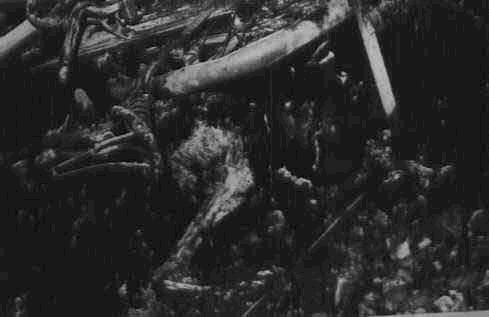
Decomposing body in a shallow grave, from an Amnesty International report, June 1984
The determined hardcore liberation ‘boys’ never get caught, said a senior Government official who is naturally not in a position that allows him to be identified. Even in rare instances where some ‘boys’ get caught, they consume the cyanide they carry with them and put an end to themselves, he observed.
Travelling by the only train operating to Jaffna, this correspondent saw virtually all the passengers getting tense as the train crossed into the Tamil areas. Military men in uniform, tough looking guys with their loaded weapons in ready-to-shoot condition spread themselves through the compartments. In fact, it looked like entering another country with the uniformed men getting hold of passengers at random and demanding a look at their identity cards.
Indignity
At the Jaffna Railway Station as the day was wearing away, the crowd surging out of the platform was huge but none could escape the gaze, the attention and perhaps the wrath of the security forces. Jaffna town itself looks to a casual visitor normal and calm, but the superficiality dissolves after he has been there for some hours. He will see military trucks roaring through the roads at intervals ‘itching for a brush with the other road users’. In their own homeland, lamented another Government official, Tamils suffer ‘the indignity of having to carry identity cards with them all the time as in South Africa’. ‘Don’t take things on their looks. Take everything on evidence.’ warned the official, his tone expressing caution and fear.
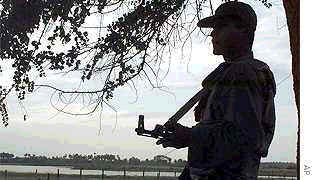 At each place visited by this correspondent, he heard the same story – the brutality unleashed by the security forces on the innocent civilian population in the shape of rounding up boys between the ages of 18 and 35 for torture, burning houses, churches and the market place and so on. The closer one moves to the different areas, the more apparent becomes the ‘misdeeds’ of the servicemen. Wherever one went, one could find the people in mourning for somebody in the family killed by army men or emotionally upset for boys rounded up from their families. Perhaps for the 100th time, this correspondent listened to people saying the army in the North frequently went berserk. The tally of ‘incidents’ reported by the people is long.
At each place visited by this correspondent, he heard the same story – the brutality unleashed by the security forces on the innocent civilian population in the shape of rounding up boys between the ages of 18 and 35 for torture, burning houses, churches and the market place and so on. The closer one moves to the different areas, the more apparent becomes the ‘misdeeds’ of the servicemen. Wherever one went, one could find the people in mourning for somebody in the family killed by army men or emotionally upset for boys rounded up from their families. Perhaps for the 100th time, this correspondent listened to people saying the army in the North frequently went berserk. The tally of ‘incidents’ reported by the people is long.
One of the dastardly acts by the security forces commonly spoken about in the Tamil areas is the indiscriminate rounding up of boys between the ages of 18 and 35 (and sometimes also older men and even women) for interrogation following some militants’ act of terrorism somewhere. ‘At this rate in another 10 years there would be no youth left among the Tamil population’, said a former Member of Parliament, Mr.Vythilingam with understandable exaggeration.
Synonym for torture
In the weeks preceding this correspondent’s visit, some 650 boys, largely from Valvettiturai and Point Pedro, were forcibly taken by the armed forces. In many cases, it was the parent who produced them to the military authorities. This is what Mr.K.C.Adiapathan, Secretary of the Valvettiturai Citizens Committee, has to say: ‘Over the loudspeaker the army asks people to bring to the Community Centre all youths of 18 to 25 years with their national identity cards for inquiry and immediate release. The people cooperate by producing the boys from their houses and expect them to be returned soon after honest interrogation. But no such thing takes place. Instead, the boys are taken to the Palaly camp and to distant places in the far south for interrogation, perhaps a synonym for torture. Not all the captured boys return even after torture. In every batch, some 25 percent of the boys are seen missing.’
Lawyers and other knowledgeable people say that such acts by the military are in contravention of the new emergency regulation requiring that no person arrested shall remain in military custody for more than 48 hours, and also requiring that information of the arrest be communicated to the Government Agent concerned within that period. It appears that the regulation is being violated with impunity considering that some of the Government agents themselves have not been able to give the approaching people the whereabouts of their missing children.
The experience of Mrs.Rajalakshumy Pancharatnam of Anaicoddai is heart-rending. Some time in May, she produced her son Vihas alias Babu at the Jaffna police station on the army’s direction. Two days later, she learnt the boy was in Jaffna Hospital with injuries. But the Government Agent informed her later that against medical advice the boy had been taken to Colombo from the Jaffna Hospital. A month later she was told that her son has died in Colombo. When she went to Colombo, she was allowed to see only the face of the boy while the remaining portion of the body was covered.
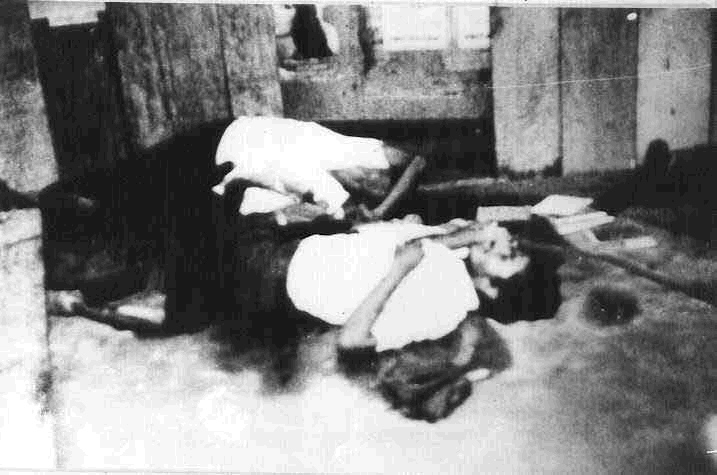
Students killed by army in Jaffna
Another moving interview brought out the poignant tale of how brutally a 43-year old person was assaulted in army custody. Alagaratnam Sivaramachandran of Maniamthoddam, Jaffna, a cottage industrialist, was taken into custody at his doorstep and moved to the Jaffna Stadium Camp along with five others from the locality, including his neighbour, Reginald. He and the others were asked to stand in a narrow trench the whole night and when he asked for water to drink, he was given a handful of stones.
During the ‘questioning’ the army removed his clothes, tied his hands, and put him down face forwards. He was asked to implicate Reginald in certain things and when he said he was not aware of anything, he was beaten until he was unconscious. With a bleeding head injury he was asked to go home by bus when he could hardly walk. Later, he had to be operated on for haematoma (blood tumour) in the Jaffna Hospital. He is still confined to his house, unable to carry on his normal work. ‘What have I to do with the Tigers to deserve this barbarous treatment at the hands of the most indisciplined army in the world’, asked Sivaramachandran.
Parent’s agony
Or witness the fate of another boy who has not come back from military custody weeks after he was rounded up. The 21-year-old Kumara Kuruparan was nursing his sick father at Valvettiturai when he was asked for his identity card by army men who suddenly entered his house one afternoon in August. He produced it but that was not the end of it. He was taken away for interrogation but did not return home. ‘Did you not take steps to find out his whereabouts’, the boy’s father was asked.
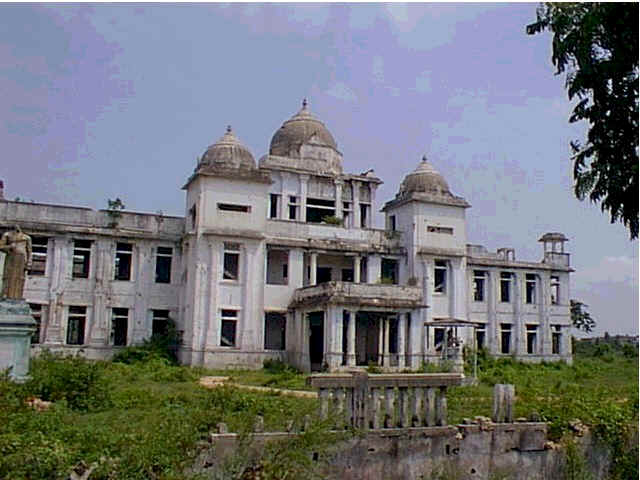
Jaffna Library 1984
‘For weeks I was in touch with the Government Agent and through him with the military authorities only to be told in the end that no boy of that description was ever taken into custody’, remonstrated Mr.K.K.Balasubramaniam, the boy’s father, a senior lawyer and notary, advanced in years with the experience etched in his wrinkles. He had been operated on for kidney and heart troubles and was convalescing when his son was forcibly taken away. On the day he was met, he received a formal letter from the Army Commander Brig.Balthassar, saying his boy was not in military custody.
The old man, in impotent rage, says he is not going to leave things at that. He will be going to the Supreme Court on a habeas corpus writ. But it will be a pity if he is not able to establish the identity of the uniformed person or persons who actually effected the boy’s arrest. Many may not know the uniformed men do not sport distinctive numbers for facilitating identification. A top official in the Jaffna district administration drew attention to another act of army vandalism aimed at destroying books pertaining to the Tamils’ past and their culture. ‘If this is not cultural genocide what else is?’ he asked.
Burning of library
The ‘security forces’ have to their credit a hat-trick performance. First it was the Jaffna Public Library, destroyed in 1981. Then came the burning of the Hartley College Library earlier this year, followed by the burning of the collection of 500 odd books belonging to one Nagamani Vijayaratnam in Point Pedro.
Founded by an English scholar missionary, Peter Percival Hartley over a century ago, Hartley College, an apex institution for the whole of Vadamarachchy area which has produced engineers, doctors, distinguished civil servants and scientists including Prof.Eliezer (mathematician of renown) and Alwarpillai (a distinguished civil servant) had the misfortune of being in the vandals’ path. The second major library to go up in flames in three years, the Point Pedro Hartley College Library was burnt along with the classrooms and care was taken to ensure that no books were spared. The principal of the College took this writer around, explaining the extensive damage to the buildings and the furniture. ‘The armed forces, mind you, avenged some defeat for the security forces at Thikkam’, he noted.
Pointing to the building next door – where the police commando unit is located – he noted that this kind of atmosphere is hardly conducive to study. The parents are afraid of sending the children to college as long as the commandos are in the neighbouring compound. To mark their solidarity with the Hartley boys and to express their concern over the random arrests and assaults by the armed forces and the police commandos, tens of thousands of students kept away from school for a whole week.
The Principal said it was a matter deeper than the mere loss of learning days. He wondered whether the Government would with a sense of remorse arrange for assistance to restore and reconstitute the 100 year old library burnt down by security forces on September 1.
This raised the question of what compensation the Government paid for the wanton destruction, again by the security forces, of the Jaffna Public Library in 1981 on the eve of the election to the D.D.C. The information showed that it had not heeded the recommendation of Lionel Fernando that Rs.10 millions be paid by the State for rebuilding the library, and the President instead had allotted just Rs.1 million from his relief fund for the purpose. ‘Burning libraries anywhere is an act of cultural genocide amounting to a crime against humanity. But when the acts are perpetrated by the very forces maintained by the revenues raised from the citizens, it is, to say the least, shocking’, he concluded.
Unarmed and under siege – Jaffna Today 2
By S.Parthasarathy
[courtesy, The Hindu, Madras, Oct.18, 1984]
Never before had the Tamil speaking people in the Northern Province, more particularly in the Jaffna Peninsula, faced such brutal and savage onslaughts from the security forces. The President, Mr.J.R.Jayewardene is apparently unmoved and is in no mood to respond to appeals to bring to an end ‘the barbarousness of the armed forces’ and to withdraw them totally from their land.
Most of the people this correspondent talked to still do not subscribe to a separate Eelam (Tamil word to denote a separate soverign State comprising all the Tamil speaking areas of Sri Lanka). They had been alienated by previous spells of rioting, official discrimination, and in Tamil majority areas by the rough treatment at the hands of the ill-disciplined, mainly Sinhalese security forces. Several of them noted that at this rate, a stage would be reached soon when the entire population might decide on separation as the only solution.
The Tamils may cease to be receptive to appeals from the capital. Students, cab drivers, doctors, engineers, officers, petty officials, businessmen and politicians speak with one voice about the undependability of the Government when it comes to any kind of agreement on the future of the culturally and linguistically distinct Tamil population in the island.
An unarmed population, men, women and children, feel they are kept under a kind of siege, within the peninsula by an armed force of several thousand men. One bank official pointed out that when there was a robbery in the bank on a certain night and when the occurrence was reported promptly to the police and the army, neither of them cared to visit the scene till the next morning; they felt safe to come only in broad daylight and sprayed bullets indiscriminately, killing passers-by. It was only when the doctors from the hospital opposite protested saying they would stop treating wounded servicemen, did the armed forces halt their madness, said one eyewitness. He also said policemen were not available for law and order duties as they were afraid to come out of the police station. This naturally encouraged criminals to indulge in vandalism.
Normal life disrupted
In other ways too, normal life remains disrupted. With a number of banks robbed, there is dearth of money in circulation. One therefore sees a long queue of people at the two banks, open for two hours a day. Shops are open only for a few hours. Not all of them are well stocked. The roads are in an awful state of dis-repair. A high official of the Jaffna Municipality expressed his regret that the Government decision to starve the Tamil areas of resources for development should have applied even to routine maintenance expenditure like the upkeep of roads. Likewise, the Jaffna Hospital, once known as the second best hospital in the island, lags far behind some of the others.
No funds are forthcoming for improving its facilities, nor even for maintaining the services at the present level. Bus services are curtailed considerably and only one train is running between Colombo and Jaffna. One can go on like this – listing the inadequacies in the infrastructure of Jaffna brought about directly by Government action.
Stories of reprisal
After this correspondent had been in Jaffna for some time, people came forward with stories of army reprisal, more and more fearful and terrible, following successive acts of militants in various parts of the Northern province.
To avenge the acts of militants, the police and the army seize passenger vehicles and deal with the occupants in a savage manner. One of the few survivors in the Vavuniya bus massacre (of September 11) narrated the gruesome tragedy in gory detail. While Kandasami Thurai, father of Ravi, one of the passengers in the Jaffna-bound bus done to death by army men, was too dazed to speak. Christopher Bastiam Pillai Anandaraja (20), a passenger who left Colombo Fort at 8 pm on September 10, was forthcoming. Around 2.30 am, when the bus was proceeding towards Jaffna after a refreshment halt at Rambawewa, five sturdy, stern looking men, one of them in military uniform, with loaded rifles/stenguns (in the darkness he could not clearly identify the weapon), ordered the driver to stop the bus ten kilometres from Vavuniya and got into it. ‘I heard them calling death to the Tamils whose terrorists had killed nine army men the previous day in Mullaitivu and I got jittery’, he said.
The bus was carrying 46 passengers including a number of women. The intruders appeared fully drunk. There was a change of driver at Rambawewa and the driver (a Tamil) who was replaced at the wheel was pulled out of the vehicle as he was crying ‘Muruga, Muruga’ and shot dead.
Some 15 passengers were asked to dismount and as they were fleeing the army men shot at their backs and killed them. Some cried they were Muslims and some others mumbled ‘Buddha, Buddha’ meaning they were Sinhalese and they were given a sound beating and ordered to disperse. ‘I was hiding myself underneath a seat. But they soon found me out and dragged me out beating me with the rifle butt while another soldier kicked me on the face with his heavy boots. I crawled underneath the vehicle and as the attention of the army men got diverted to the two girl passengers, I and four others managed to escape to a village in the jungle some miles away and later to Jaffna.’
17 persons massacred
Altogether, 17 persons were massacred in the bus incident and some lost their legs or sustained gun shot injuries, according to Anandaraja. Visibly shaken, he said he had decided to leave the country. Vasanthakumar (20) spoke of the establishment of army camps in all the colleges in Mullaitivu. He also spoke of the way the boys rounded-up were treated – being ordered to lie flat on the floor and being beaten till they bled. Even 65-70 year old people were taken into custody. With tears welling in his eyes, he described the barbarous manner in which some 20 boys and a 65 year-old man were shot dead by the armed forces and said that one of the terms for returning the bodies was that the parents should sign statement that they were all ‘terrorists’. One parent at least refused to sign such a statement and did not want the body of his ward on such a condition.
People live in fear
For some time it has been a regular feature for the naval vessels to fire projectiles from the sea on the coastal village in Point Pedro, Valvettiturai, etc. In Point Pedro, as the parish priest was preparing for the Sunday liturgy, the assault was on. Some projectiles hit the parish house and a splinter hit the high roof right above the altar. A few houses behind the church which were hit and damaged were shown to this correspondent by the people of the locality.
The people are in constant dread of being injured or killed as it happened on September 15 at Polykandy (quite some distance from the coast) where Kalavathy was killed. Her husband Thangathurai, a cobbler by profession, was also sustained serious injury by one shell and was incapacitated for life, told this correspondent that one shell penetrated his wife’s head. She was later admitted to hospital where she died.
The projectiles fired by the gun boat hit coconut trees and houses even some distance away from the coast. On September 9, ‘one shell fell on my house’, said T.Ramachandran of Kunchcham Lane. The shell broke into fragments, breaking a large number of tiles. The impact was so great that the beam was broken into two. Mrs.S.Nadanalingam was injured in her right ankle by a shell. Another shell was reported to have travelled three-fourths of a mile, and bounced off after hitting a tree close to the parapet wall at an angle of 45 degree.
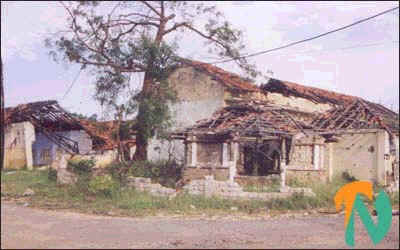
The projectiles did not come only from the sea. They came from moving armoured vehicles too, hitting houses. Police commandos fired shells from moving vehicles in Point Pedro at the house of a retired postmaster. In another shelling, they killed one Sadacharam and crippled a 65-year old woman, Mrs.Chellappa in the second week of September.
Jaffna citizens remember with awe the declaration of Mr.Jayewardene calling upon the army to eliminate in accordance with the laws of the land the menace of terrorism in all its forms from the island and more especially from Jaffna district, and placing at its disposal all the resources of the State. This task supposed to have been completed before 1980 but remaining far from being accomplished, the people think that new methods are being adopted by the Government. They see a stark qualitative change in the methods of repression.
Israeli hand
They see the Israeli hand in the new methods and are not carried away by the tweedledum-tweedledee type of difference between Mossad and Shinbet. In particular, the blast on August 12 in the Chunnakam police station vacated overnight by the police killing innocent people and other inhuman acts involving the burning of civilian homes are attributed to Israeli masterminding. The people believe the Israelis may be tendering advice to the Government on settling Sinhalese colonists in the Tamil areas of the dry zone in Vavuniya, Mannar, Valvettiturai, Mullaitivu and so on – on the lines of the Israeli settlements in Palestinian homes in the Gaza strip and the banks of the Jordan river.
With the naval bombardment of coastal areas becoming a regular feature and the naval surveillance intensifying, fishermen cannot go out fishing. K.Tharmaraja (32) and Balasingam Vigneswaran (19) from a coastal village off Point Pedro said that when they went out into the sea on August 6 in a trawler, they were intercepted by the navy men and driven back to the shore with a warning against venturing out again. ‘From father to son for hundreds of years we follow the sea. What do we do now for our living?’ they asked.
What is in store for the Tamil people? ‘The 100 perceent Sinhala army behaving like an occupation army in a 100 percent Tamil country creates a situation motivating ethnic genocide – an ideal setting for a slow and noiseless genocide’, said Deogu Pillai, Bishop of Jaffna, throwing up his hands in despair.